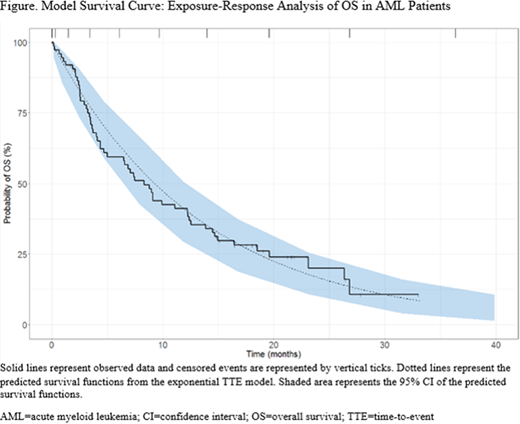Abstract
Introduction: Glasdegib is an inhibitor of the Hedgehog signaling pathway through binding to its target, Smoothened (SMO). B1371003 was a Phase 1b/2 study evaluating glasdegib in combination with chemotherapy in patients with acute myeloid leukemia (AML). In one part of the Phase 2 portion of B1371003, patients who were not candidates for more standard chemotherapy were randomized 2:1 to receive low-dose cytarabine (LDAC) with glasdegib or LDAC alone. The primary endpoint was overall survival (OS). A Cox regression analysis for overall survival (OS) was conducted, and median OS for AML patients treated with glasdegib plus LDAC was 8.3 months compared to 4.3 months with LDAC alone (hazard ratio [HR] 0.463). This analysis aimed to assess the potential relationship between glasdegib exposure and OS (exposure-response [ER]) and to evaluate the effect on OS of moderators/covariates, including treatment-response (TR) for glasdegib + LDAC vs. LDAC alone.
Methods: The analyses included data from the Phase 2 non-intensive AML patients. Glasdegib was administered continuously at 100 mg once daily (QD) orally in 28-day cycles. LDAC was administered subcutaneously at 20 mg twice daily on Days 1-10 of each 28-day cycle. Glasdegib exposure from the glasdegib + LDAC treated arm was estimated utilizing a population pharmacokinetics (PK) model. Survival was assessed at every visit then every month for the first 2 months after discontinuation from study treatment and thereafter every 2 months until death or termination of the study.
Parametric time-to-event survival models were used to assess the relationship between OS, treatment arm, and glasdegib exposure. Baseline characteristics (such as age, sex, body weight, and white blood cell count) and other prognostic factors (such as disease status and treatment arm) were evaluated as potential predictors of OS by forward inclusion and backward elimination. R statistical programming (version 3.2.2) and NONMEM software (version 7.3.0) were used for the analysis.
Results: Glasdegib PK was adequately characterized by a 2-compartment model with first order absorption kinetics. Demographic and baseline characteristics such as age, sex, body weight, and renal and hepatic function were either non-significant or did not have a clinically relevant impact on glasdegib PK. The TR analysis included all Phase 2 AML patients with available OS data who were randomized to receive LDAC with (n=78) or without (n=38) glasdegib. Glasdegib-treated patients with at least one PK observation (n=75) were evaluated in the ER analysis. Exponential, Weibull, and log-logistic parametric distributions were explored, and the exponential distribution was selected as the model that best described the observed OS data (Figure). In the TR analysis, addition of glasdegib to LDAC resulted in longer OS with HR of 0.42 (95% confidence interval: 0.28-0.66). No ER relationship was identified in the analysis between glasdegib plasma exposures at 100 mg QD and OS. No other baseline characteristics were identified as potential predictors of survival in either the TR or ER analyses.
Conclusions: Addition of glasdegib treatment to LDAC chemotherapy in AML patients who are not suitable for intensive chemotherapy significantly prolonged OS compared to LDAC chemotherapy alone. Across the range of plasma exposures for glasdegib 100-mg QD treatment, no ER relationship was identified. No other covariates were found to be predictors of survival, therefore supporting the broad use of glasdegib as an addition to chemotherapy in AML patients.
Lin:Pfizer: Employment. Shaik:Pfizer Inc: Employment, Equity Ownership. Chan:Pfizer: Employment, Equity Ownership. Cortes:Daiichi Sankyo: Consultancy, Research Funding; Astellas Pharma: Consultancy, Research Funding; Pfizer: Consultancy, Research Funding; Novartis: Consultancy, Research Funding; Arog: Research Funding. Ruiz-Garcia:Pfizer: Employment, Equity Ownership.
Author notes
Asterisk with author names denotes non-ASH members.


This feature is available to Subscribers Only
Sign In or Create an Account Close Modal